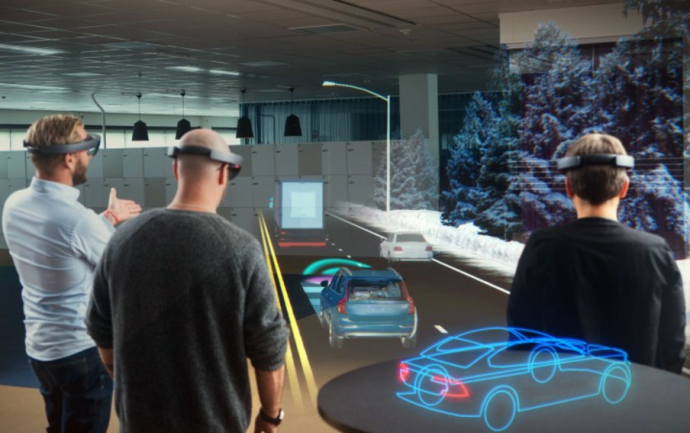
The New York-based investment bank Goldman Sachs recently published an in-depth report onVirtual Reality (VR) and Augmented Reality (AR)’s market potential. Led by Heather Bellini, managing director of the telecom and media business unit, the report indicates that virtual reality and augmented reality are paving the way to a $80 billion market opportunity by 2025.
What’s $80 billion? Assuming an entrepreneur captures a 10% market share, he or she would be heading a startup-turned-Fortune-500-company in no less than eight years. Such a feat would surpass Google, Amazon, Apple and Facebook’s exponential growth – all of which epitomize Silicon Valley’s innovation leadership? How does one get to the $80 billion dollar figure? And what’s the market opportunity potential for those companies focused on the business-to-business market space?
I/ Sizing the Virtual Reality and Augmented Reality market
The $80 billion figure is a result of two elements:
- 1/ Virtual Reality (VR) and Augmented Reality (AR) software which is estimated at $35 billion.
- 2/ The hardware necessary to experience virtual reality and augmented reality which is equal to $45 billion.
As often in the digital world, hardware purchases turn out to be necessary in order to experience a diversity of virtual reality and augmented reality use cases, including video games, live events, military applications, engineering, education, healthcare video entertainment and retail. In other words, virtual reality and augmented reality hardware is agnostic to applications whereas software is almost always specific to an application. In other words, you would need to have virtual-reality glasses in order to play virtual reality video games. But you can use the same pair of virtual reality glasses for a different use case, such as healthcare. Software is use-case specific; hardware is not.
In order to get to the $35 billion estimate for virtual-reality software, the report identifies nine use cases and aims anticipating market growth rates, based on
- existing players for short term predictions (2017 to 2020)
- past technology developments (smartphone, PC, tablets) for long term predictions (2025).
The video game application seems to be the most promising with $11.6 billion. Healthcare is valued at $5,1 billion while the live event market is estimated at $4,1 billion. All in all, business-to-business virtual reality and augmented reality applications can tap into $8,9 billion where the retail use case amounts to a $1,6 billion market, real estate reaches $2,6 billion and engineering adds up to $4,7 billion.
II/ What are the Virtual Reality and Augmented Reality applications?
For example, in healthcare, virtual reality can help people suffering from agoraphobia to experience being immersed in a crowd virtually without being in the crowd, effectively. This is a way to get the patient’s brain used to experiencing situations without having to be in those situations in real life. Such an approach is part of a healthcare protocol.
Virtual reality can also be useful to surgeons to practice before starting complex surgery.
In retail, virtual reality can help clients in many ways. Assuming that you would like to buy a new appliance to your kitchen, you can position it into your virtual-reality duplicated kitchen and see if it fits conveniently.
Are you considering moving or buying a new home? In this case, virtual reality can give you a virtual reality-based tour of some of the most relevant houses that you’ve identified. This can be very time saving both for the client as well as a real estate agent.
Perhaps one of the most promising virtual reality and augmented reality applications in the industrial world would be product-prototyping and development. Engineers are spending a lot of time and money on developing products which you need to build effectively to see how they come out. They use these prototypes to make a number of trials and tests which may lead to improve their product in a number of different ways. Virtual reality and augmented reality are useful to engineers who can visualize their products as if they were real—building the product may no longer be necessary. This means shorter product development cycles, lower development costs, and increased collaboration worldwide as teams from around the world can log into the virtual reality prototype and participates actively wherever their location.
III/ France and the opportunity for Virtual Reality and Augmented Reality
France is often considered to be a center for talent in the virtual reality and augmented reality space. There is in France a strong mathematical tradition providing the necessary technical talent in order to build fluid virtual reality and augmented reality experiences. But there’s also a strong tradition in animated films where a school like Les Gobelins is providing talents to leading American animation studios, such as Pixar and Disney. A leader from Facebook recently told me that he considers Paris to be number 1 for virtual reality and augmented reality talent.
France is also home to some very promising companies which could take a foothold in the virtual reality and augmented reality space. These include companies like that Dassault Systèmes which is developing 3D prototyping software for the air manufacturing space.
Ubisoft, a video game company, is developing virtual reality games some of which take place in Paris given a first purview into the city of lights.
Personally, I can also see many applications of virtual reality in tourism. France is the number one touristic destination the world. As spending power will be shifting to the Asian middle-class especially in India and China, offering virtual reality-based tourism can be a great way to engage with middle-class consumers in China and India and create a stronger desire for them to visit France in real life. Just imagine what it would be like to visit the Chateau de Versailles, the Louvres, the Paris Opera and Les Chateaux de la Loire in virtual reality?

[…] article Virtual Reality and Augmented Reality : a $8,9 billion market opportunity in the B2B space est apparu en premier sur The Innovation and Strategy […]